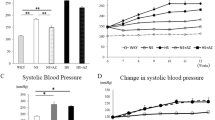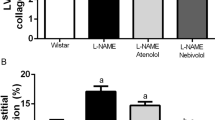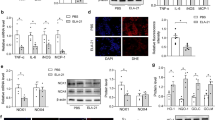Abstract
The aim of this study was to determine whether exogenous administration of C-type natriuretic peptide (CNP) induces functional and morphological vascular changes in spontaneously hypertensive rats (SHR) compared with normotensive rats. Male 12-week-old normotensive Wistar and SHR were administered with saline (NaCl 0.9%) or CNP (0.75 μg/h/100 g) for 14 days (subcutaneous micro-osmotic pumps). Systolic blood pressure (SBP) was measured in awake animals and renal parameters were evaluated. After decapitation, the aorta was removed, and vascular morphology, profibrotic markers, and vascular reactivity were measured. In addition, nitric oxide (NO) system and oxidative stress were evaluated. After 14-days of treatment, CNP effectively reduced SBP in SHR without changes in renal function. CNP attenuated vascular remodeling in hypertensive rats, diminishing both profibrotic and pro-inflammatory cytokines. Also, CNP activated the vascular NO system and exerted an antioxidant effect in aortic tissue of both groups, diminishing superoxide production and thiobarbituric acid-reactive substances, and increasing glutathione content. These results show that chronic treatment with CNP attenuates the vascular damage development in a model of essential hypertension, inducing changes in fibrotic, inflammatory, oxidative, and NO pathways that could contribute to beneficial long-term effects on vascular morphology, extracellular matrix composition, and function. The knowledge of these effects of CNP could lead to improved therapeutic strategies to not only control BP but also reduce vascular damage, primarily responsible for the risk of cardiovascular events.







Similar content being viewed by others
References
Arejian M, Li Y, Anand-Srivastava MB (2009) Nitric oxide attenuates the expression of natriuretic peptide receptor C and associated adenylyl cyclase signaling in aortic vascular smooth muscle cells: role of MAPK. Am J Physiol Heart Circ Physiol 296(6):H1859–H1867. https://doi.org/10.1152/ajpheart.01108.2008
Barcellos-Hoff MH, Dix TA (1996) Redox-mediated activation of latent transforming growth factor-beta1. Mol Endocrinol 10:1077–1083. https://doi.org/10.1210/mend.10.9.8885242
Caniffi C, Cerniello FM, Gobetto MN, Sueiro ML, Costa MA, Arranz C (2016) Vascular tone regulation induced by C-type natriuretic peptide: differences in endothelium-dependent and -independent mechanisms involved in normotensive and spontaneously hypertensive rats. PLoS One 11(12):e0167817. https://doi.org/10.1371/journal.pone.0167817
Caniffi C, Elesgaray R, Gironacci M, Arranz CT, Costa MA (2010) C-type natriuretic peptide effects on cardiovascular nitric oxide system in spontaneously hypertensive rats. Peptides 31(7):1309–1318. https://doi.org/10.1016/j.peptides.2010.03.030
Ceron CS, Rizzi E, Guimaraes DA, Martins-Oliveira A, Cau SB, Ramos J, Gerlach RF, Tanus-Santos JE (2012) Time course involvement of matrix metalloproteinases in the vascular alterations of renovascular hypertension. Matrix Biol 31(4):261–270. https://doi.org/10.1016/j.matbio.2012.01.009
Costa MA, Elesgaray R, Caniffi C, Fellet A, Arranz C (2007) Role of cardiovascular nitric oxide system in C-type natriuretic peptide effects. Biochem Biophys Res Commun 359(1):180–186. https://doi.org/10.1016/j.bbrc.2007.05.095
Crabos M, Coste P, Paccalin M, Tariosse L, Daret D, Besse P, Bonoron-Adèle S (1997) Reduce basal NO-mediated dilation and decreased NO-synthase expression in coronary vessels of spontaneously hypertensive rats. J Mol Cell Cardiol 29:55–65. https://doi.org/10.1006/jmcc.1996.0251
Cucoranu I, Clempus R, Dikalova A, Phelan PJ, Ariyan S, Dikalov S, Sorescu D (2009) NAD(P) H oxidase 4 mediates transforming growth factor-beta1-induced differentiation of cardiac fibroblasts into myofibroblasts. Circ Res 97:900–907. https://doi.org/10.1161/01.RES.0000187457.24338.3D
De Caterina R, Libby P, Peng HB, Thannickal VJ, Rajavashisth TB, Gimbrone MA Jr et al (1995) Nitric oxide decreases cytokine-induced endothelial activation. Nitric oxide selectively reduces endothelial expression of adhesion molecules and proinflammatory cytokines. J Clin Invest 96(1):60–68. https://doi.org/10.1172/JCI118074
D'Souza SP, Davis M, Baxter GF (2004) Autocrine and paracrine actions of natriuretic peptides in the heart. Pharmacol Ther 101(2):113–129. https://doi.org/10.1016/j.pharmthera.2003.11.001
Dubois G (1996) Decreased L-arginine-nitric oxide pathway in cultured myoblasts from spontaneously hypertensive versus normotensive Wistar-Kyoto rats. FEBS Lett 392(3):242–244
Giani JF, Miquet JG, Muñoz MC, Burghi V, Toblli JE, Masternak MM, Kopchick JJ, Bartke A, Turyn D, Dominici FP (2012) Upregulation of the angiotensin-converting enzyme 2/angiotensin-(1-7)/Mas receptor axis in the heart and the kidney of growth hormone receptor knock-out mice. Growth Hormon IGF Res 22(6):224–233. https://doi.org/10.1016/j.ghir.2012.08.003
Gonzalez W, Fontaine V, Pueyo ME, Laquay N, Messika-Zeitoun D, Philippe M, Arnal JF̧, Jacob MP, Michel JB (2000) Molecular plasticity of vascular wall during N(G)-nitro-L-arginine methyl ester-induced hypertension: modulation of proinflammatory signals. Hypertension 36(1):103–109
Intengan HD, Schiffrin EL (2001) Vascular remodeling in hypertension: roles of apoptosis, inflammation, and fibrosis. Hypertension 38(3 Pt 2):581–587
Itoh T, Nagaya N, Murakami S, Fujii T, Iwase T, Ishibashi-Ueda H, Yutani C, Yamagishi M, Kimura H, Kangawa K (2004) C-type natriuretic peptide ameliorates monocrotaline-induced pulmonary hypertension in rats. Am J Respir Crit Care Med 170(11):1204–1211. https://doi.org/10.1164/rccm.200404-455OC
Jiang F, Liu GS, Dusting GJ, Chan EC (2014) NADPH oxidase-dependent redox signaling in TGF-β-mediated fibrotic responses. Redox Biol 2:267–272. https://doi.org/10.1016/j.redox.2014.01.012
Kelsall CJ, Chester AH, Sarathchandra P, Singer DRJ (2006) Expression and localization of C-type natriuretic peptide in human vascular smooth muscle cells. Vasc Pharmacol 45:368–373. https://doi.org/10.1016/j.vph.2006.06.011
Leong XF, Ng CY, Jaarin K (2015) Animal models in cardiovascular research: hypertension and atherosclerosis. Biomed Res Int 2015:528757. https://doi.org/10.1155/2015/528757
Li Y, Sarkar O, Brochu M, Anand-Srivastava MB (2014) Natriuretic peptide receptor-C attenuates hypertension in spontaneously hypertensive rats: role of nitroxidative stress and Gi proteins. Hypertension 63(4):846–855. https://doi.org/10.1161/HYPERTENSIONAHA.113.01772
Liang C, Zhang Y, Zhuo D, Lo CY, Yu L, Lau CW, Kwan YW, Tse G, Huang Y, Yao X (2019) Endothelial cell transient receptor potential channel C5 (TRPC5) is essential for endothelium-dependent contraction in mouse carotid arteries. Biochem Pharmacol 159:11–24. https://doi.org/10.1016/j.bcp.2018.11.002
Magnani ND, Marchini T, Vanasco V, Tasat DR, Alvarez S, Evelson P (2013) Reactive oxygen species produced by NADPH oxidase and mitochondrial dysfunction in lung after an acute exposure to residual oil fly ashes. Toxicol Appl Pharmacol 270(1):31–38. https://doi.org/10.1016/j.taap.2013.04.002
Mangiafico S, Costello-Boerrigter LC, Andersen IA, Cataliotti A, Burnett JC Jr (2013) Neutral endopeptidase inhibition and the natriuretic peptide system: an evolving strategy in cardiovascular therapeutics. Eur Heart J 34(12):886–893c. https://doi.org/10.1093/eurheartj/ehs262
Marchini T, Magnani ND, Paz ML, Vanasco V, Tasat D, González Maglio DH, Alvarez S, Evelson PA (2014) Time course of systemic oxidative stress and inflammatory response induced by an acute exposure to Residual Oil Fly Ash. Toxicol Appl Pharmacol 274(2):274–282. https://doi.org/10.1016/j.taap.2013.11.013
McCaffrey TA (2000) TGF-betas and TGF-beta receptors in atherosclerosis. Cytokine Growth Factor Rev 11(1–2):103–114
Moyes AJ, Khambata RS, Villar I, Bubb KJ, Baliga RS, Lumsden NG, Xiao F, Gane PJ, Rebstock AS, Worthington RJ, Simone MI, Mota F, Rivilla F, Vallejo S, Peiró C, Sánchez Ferrer CF, Djordjevic S, Caulfield MJ, MacAllister RJ, Selwood DL, Ahluwalia A, Hobbs AJ (2014) Endothelial C-type natriuretic peptide maintains vascular homeostasis. J Clin Invest 124(9):4039–4051. https://doi.org/10.1172/JCI74281
Osterbur K, Yu DH, DeClue AE (2013) Interleukin-1β, tumor necrosis factor-α and lipopolysaccharide induce C-type natriuretic peptide from canine aortic endothelial cells. Res Vet Sci 94(3):478–483. https://doi.org/10.1016/j.rvsc.2012.10.002
Piech A, Dessy C, Havaux X, Feron O, Balligand JL (2003) Differential regulation of nitric oxide synthases and their allosteric regulators in heart and vessels of hypertensive rats. Cardiovasc Res 57(2):456–467
Pieraggi M, Nejjar I, Julian M, Bouissou H (1986) Staining of elastic tissue by Verhoeff’s iron hematoxylin. Ann Pathol 6(1):74–77
Pollman MJ, Naumovski L, Gibbons GH (1999) Vascular cell apoptosis: cell type-specific modulation by transforming growth factor-beta1 in endothelial cells versus smooth muscle cells. Circulation 99:2019–2026
Qian JY, Haruno A, Asada Y, Nishida T, Saito Y, Matsuda T, Ueno H (2002) Local expression of C-type natriuretic peptide suppresses inflammation, eliminates shear stress-induced thrombosis, and prevents neointima formation through enhanced nitric oxide production in rabbit injured carotid arteries. Circ Res 91(11):1063–1069
Romero M, Caniffi C, Bouchet G, Elesgaray R, McLaughlin M, Tomat A et al (2013) Sex differences in the beneficial cardiac effects of chronic treatment with atrial natriuretic peptide in spontaneously hypertensive rats. PLoS One 8(8):e71992. https://doi.org/10.1371/journal.pone.0071992
Ruiz-Ortega M, Rodríguez-Vita J, Sanchez-Lopez E, Carvajal G, Egido J (2007) TGF-beta signaling in vascular fibrosis. Cardiovasc Res 74(2):196–206. https://doi.org/10.1016/j.cardiores.2007.02.008
Saha S, Li Y, Lappas G, Anand-Srivastava MB (2008) Activation of natriuretic peptide receptor-C attenuates the enhanced oxidative stress in vascular smooth muscle cells from spontaneously hypertensive rats: implication of Gi alpha protein. J Mol Cell Cardiol 44:336–344. https://doi.org/10.1016/j.yjmcc.2007.11.003
Sanz-Rosa D, Oubiña MP, Cediel E, de las Heras N, Vegazo O, Jiménez J, Lahera V, Cachofeiro V (2005) Effect of AT1 receptor antagonism on vascular and circulating inflammatory mediators in SHR: role of NF-κB/IκB system. Am J Physiol Heart Circ Physiol 288:H111–H115. https://doi.org/10.1152/ajpheart.01061.2003
Schiffrin EL (2012) Vascular remodeling in hypertension: Mechanisms and Treatment. Hypertension 59:367–374. https://doi.org/10.1161/HYPERTENSIONAHA.111.187021
Sprague AH, Khalil RA (2009) Inflammatory cytokines in vascular dysfunction and vascular disease. Biochem Pharmacol 78:539–552. https://doi.org/10.1016/j.bcp.2009.04.029
Stingo AJ, Clavell AL, Heublein DM, Wei CM, Pittelkow MR, Burnett JCJ (1992) Presence of C-type natriuretic peptide in cultured human endothelial cells and plasma. Am J Phys 263:H1318–H1321. https://doi.org/10.1152/ajpheart.1992.263.4.H1318
Vapaatalo H, Mervaala E, Nurminen ML (2000) Role of endothelium and nitric oxide in experimental hypertension. Physiol Res 49(1):1–10
Vardeny O, Miller R, Solomon SD (2014) Combined neprilysin and renin-angiotensin system inhibition for the treatment of heart failure. J Am Coll Cardiol HF (14)00338–2. https://doi.org/10.1016/j.jchf.2014.09.001
Vaziri ND, Ni Z, Oveisi F (1998) Upregulation of renal and vascular nitric oxide synthase in young spontaneously hypertensive rats. Hypertension 31(6):1248–1254
Wagenseil JE, Mecham RP (2009) Vascular extracellular matrix and arterial mechanics. Physiol Rev 89(3):957–989. https://doi.org/10.1152/physrev.00041.2008
Acknowledgments
The authors thank Sandra Landín for secretarial work, Gabriela Noceti for technical assistance, and Ana Borthwick for proofreading and language assistance.
Funding
This study was funded by Universidad de Buenos Aires (UBA) [UBACYT: 200-201001-00060]; Consejo Nacional de Investigaciones Científicas y Técnicas (CONICET) [PIP-112-201101-00581]; and Instituto de Química y Metabolismo del Fármaco (IQUIMEFA), UBA-CONICET, Argentina.
Author information
Authors and Affiliations
Contributions
•Conceived of or designed study: Carolina Caniffi, Cristina Arranz
•Performed research: Carolina Caniffi, Flavia M. Cerniello, Gonzalo Bouchet, María L. Sueiro, Analía Tomat, Daniel González Maglio, Jorge E. Toblli
•Analyzed data: Carolina Caniffi, Flavia M. Cerniello, Daniel González Maglio, Jorge E. Toblli
•Contributed new methods or models: Carolina Caniffi, Analía Tomat, Jorge E. Toblli, Cristina Arranz
•Wrote the paper: Carolina Caniffi, Analía Tomat, Cristina Arranz
Corresponding author
Ethics declarations
Conflict of interest
The authors declare that they have no conflict of interest.
Ethical approval
All procedures performed in studies involving animals were in accordance with the ethical standards of the institution or practice at which the studies were conducted.
Additional information
Publisher’s note
Springer Nature remains neutral with regard to jurisdictional claims in published maps and institutional affiliations.
Dr. Jorge E. Toblli passed away in 2018
Rights and permissions
About this article
Cite this article
Caniffi, C., Cerniello, F.M., Bouchet, G. et al. Chronic treatment with C-type natriuretic peptide impacts differently in the aorta of normotensive and hypertensive rats. Pflugers Arch - Eur J Physiol 471, 1103–1115 (2019). https://doi.org/10.1007/s00424-019-02287-y
Received:
Revised:
Accepted:
Published:
Issue Date:
DOI: https://doi.org/10.1007/s00424-019-02287-y




